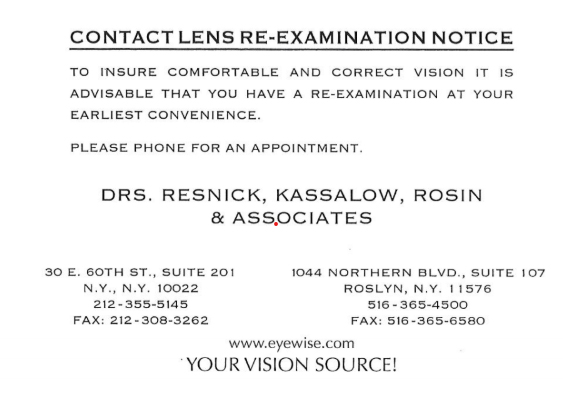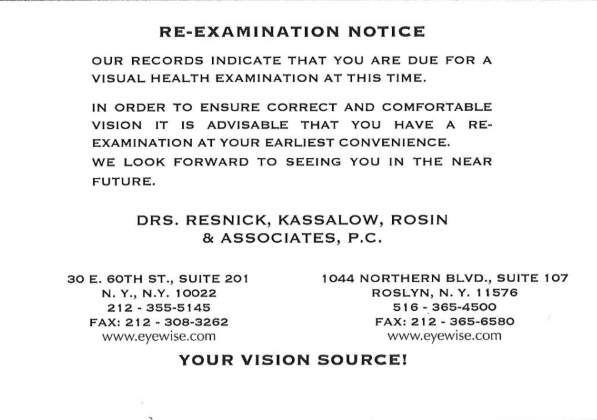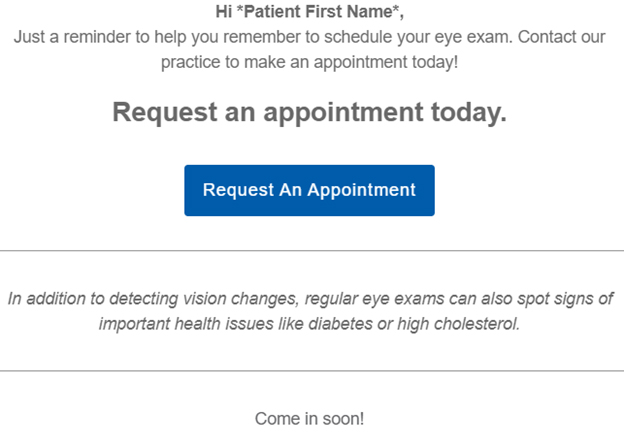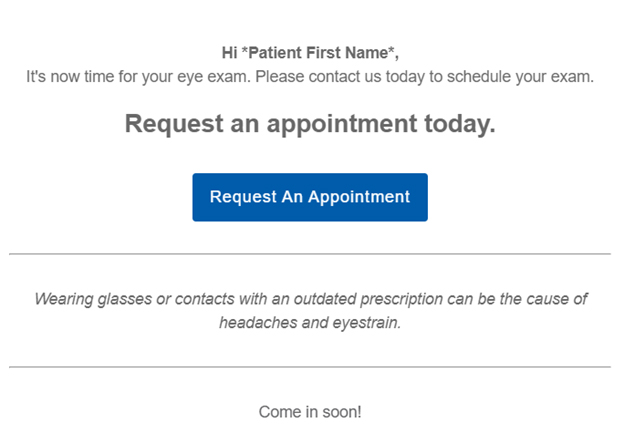By Susan Resnick, OD, FAAO, FSLS

July 8, 2020
Like most practices, our revenues are lagging behind where they should be due to the impact of the COVID-19 shutdown. Our practice is implementing strategic recall in which we give priority to some patients over others to recoup some of that lost income. Here is how we are doing it.
Create Recall Categories
To ramp up revenues most effectively, we devised a recall strategy for the three months post re-opening and beyond, if needed or desired. Our goals are to optimize clinical efficiency and outcomes, deliver the most positive patient experience and ensure financial recovery.
We selected several criteria for targeted recall, and aimed to achieve a pre-determined ratio of patient “sub-types” for each daily schedule. The recall categories we use (in no particular order) are:
1. Private-pay patients
2. “Best-spend” patients
3. Patients due for comprehensive exams who have not been seen in two years or more (i.e. more likely to need updated eyewear and contact lenses)
4. New patients
5. Specialty/medically necessary contact-lens patients
6. Dry-eye patients
7. Using proprietary products and technologies such as neurolens, Visioneering Technologies’ NaturalVue contact lenses, TearCare and Lipiflow.
We look to achieve a ratio of 75 percent of patients from one or more of the above categories with the other 25 percent of appointments allocated to lower-revenue procedures such as contact lens follow-ups.
Other Articles to Explore
We kept a list of patients to whom we had extended their contact-lens expiration dates and called them first. We then performed a filtered search within our EHR to create lists of patients fulfilling the other criteria, and are continuing to contact them by phone.
This strategy is being done concomitantly with our standard recall for patients with chronic conditions and is just being performed once. We will revert to our standard “non-targeted” recall after this “push.” What we may continue to do, however, is loosely adhere to the daily schedule ratios. I call this “intelligent booking.” In other words, have a favorable financial mix each day, while not having any needy patients wait.
Use Recall Technology & Set Schedule
In this post-COVID period we have completely reversed our traditional strategy. While pre-pandemic, our patients would first receive an e-mail and text at the six-month or 12-month interval, we have now returned to good old-fashioned phone calls. Patients appreciate the personal touch and are more easily reassured of the safety protocols and benefits of resuming preventative care.
We will follow up with e-mails if we are not able to reach them or their voicemail and/or if we do not hear back within six months. Our standard procedure will then be executed: we will send out a snail-mail reminder.
Our electronic health record system is MaximEyes by First Insight; it is from this database we filter our recall searches. During the shutdown, we sent e-mail blasts out every 10 days to two weeks, keeping all our patients up to date on how we were continuing to support their eyecare needs and informing them of our safe re-opening processes. Our messaging in our most recent e-mail emphasized how smoothly and successfully everything was running due to our careful and methodical planning and execution strategies, as well as informing them of new contact lens technologies we are offering.
We have one key team member (their title is “business administrator” in each of our locations who oversees conducting the filtered search and printing the recall lists. They then give those to our administrative supervisors (“office managers’) who assign the calls to our administrative staff. This process is the one we have always used; the only difference now is that we have tweaked the criteria.
What Our Recall Messages Look Like
These first two are printed on cards, but mailed through the postal service in envelopes for privacy:


Here are examples of the e-mails (partial “clips”) that get send out. We use Prime Nexus as our patient communication vendor/portal:


Market Specialized Care to Patients to Encourage Patient Inquiries
We believe that having a diversified “portfolio” of products and services is the best approach. To that end, we embrace technologies in contact lenses, ocular surface health and spectacle lenses that allow us to differentiate our practice. We do not rely on vendor-generated “offers,” but rather, communicate these services within our own “Making Contact” newsletter. Examples include: Therapies for Meibomian Gland Dysfunction including TearCare and Lipiflow, Myopia Management with NaturalVue MF ( off label) and currently being introduced Mi-Sight from CooperVision, new Multifocal Toric Lenses recently introduced by Bausch + Lomb and CooperVision, and Neurolens for patients with computer vision syndrome as a result of troublesome fixation disparities.
We want to do all we can to provide the highest level of care to patients while strengthening our financial footing and priming our practice for future growth.
 Susan Resnick, OD, FAAO, FSLS, is president of Drs. Farkas, Kassalow, Resnick & Associates in New York City. To contact her: sresnick525@gmail.com
Susan Resnick, OD, FAAO, FSLS, is president of Drs. Farkas, Kassalow, Resnick & Associates in New York City. To contact her: sresnick525@gmail.com

























